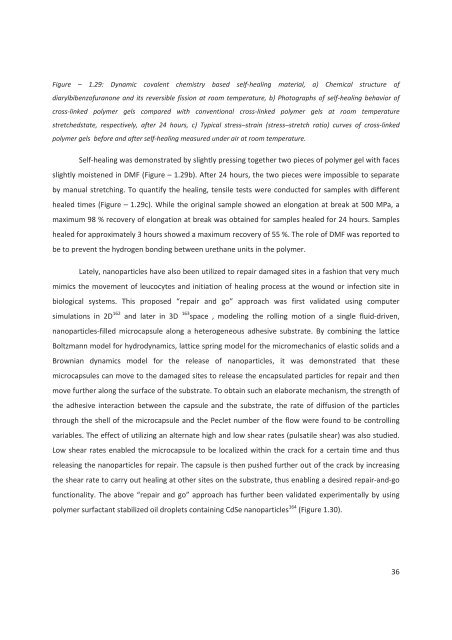4(%3)3 - Ecole nationale supérieure de chimie de Montpellier
4(%3)3 - Ecole nationale supérieure de chimie de Montpellier
4(%3)3 - Ecole nationale supérieure de chimie de Montpellier
You also want an ePaper? Increase the reach of your titles
YUMPU automatically turns print PDFs into web optimized ePapers that Google loves.
Figure – 1.29: Dynamic covalent chemistry based self-healing material, a) Chemical structure ofdiarylbibenzofuranone and its reversible fission at room temperature, b) Photographs of self-healing behavior ofcross-linked polymer gels compared with conventional cross-linked polymer gels at room temperaturestretchedstate, respectively, after 24 hours, c) Typical stress–strain (stress–stretch ratio) curves of cross-linkedpolymer gels before and after self-healing measured un<strong>de</strong>r air at room temperature.Self-healing was <strong>de</strong>monstrated by slightly pressing together two pieces of polymer gel with facesslightly moistened in DMF (Figure – 1.29b). After 24 hours, the two pieces were impossible to separateby manual stretching. To quantify the healing, tensile tests were conducted for samples with differenthealed times (Figure – 1.29c). While the original sample showed an elongation at break at 500 MPa, amaximum 98 % recovery of elongation at break was obtained for samples healed for 24 hours. Sampleshealed for approximately 3 hours showed a maximum recovery of 55 %. The role of DMF was reported tobe to prevent the hydrogen bonding between urethane units in the polymer.Lately, nanoparticles have also been utilized to repair damaged sites in a fashion that very muchmimics the movement of leucocytes and initiation of healing process at the wound or infection site inbiological systems. This proposed “repair and go” approach was first validated using computersimulations in 2D 162 and later in 3D 163 space , mo<strong>de</strong>ling the rolling motion of a single fluid-driven,nanoparticles-filled microcapsule along a heterogeneous adhesive substrate. By combining the latticeBoltzmann mo<strong>de</strong>l for hydrodynamics, lattice spring mo<strong>de</strong>l for the micromechanics of elastic solids and aBrownian dynamics mo<strong>de</strong>l for the release of nanoparticles, it was <strong>de</strong>monstrated that thesemicrocapsules can move to the damaged sites to release the encapsulated particles for repair and thenmove further along the surface of the substrate. To obtain such an elaborate mechanism, the strength ofthe adhesive interaction between the capsule and the substrate, the rate of diffusion of the particlesthrough the shell of the microcapsule and the Peclet number of the flow were found to be controllingvariables. The effect of utilizing an alternate high and low shear rates (pulsatile shear) was also studied.Low shear rates enabled the microcapsule to be localized within the crack for a certain time and thusreleasing the nanoparticles for repair. The capsule is then pushed further out of the crack by increasingthe shear rate to carry out healing at other sites on the substrate, thus enabling a <strong>de</strong>sired repair-and-gofunctionality. The above “repair and go” approach has further been validated experimentally by usingpolymer surfactant stabilized oil droplets containing CdSe nanoparticles 164 (Figure 1.30).36











